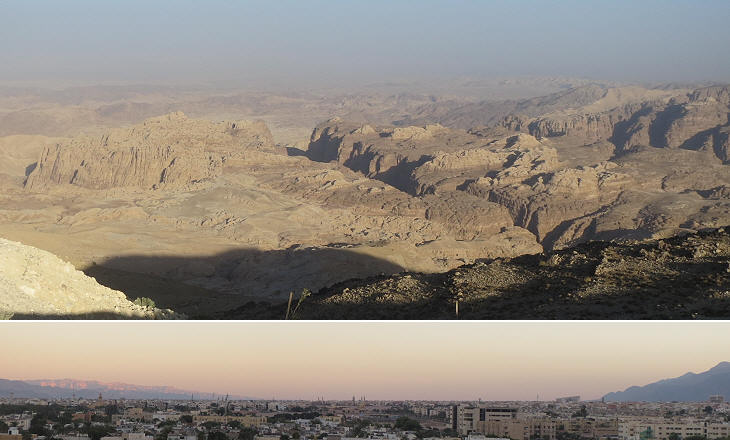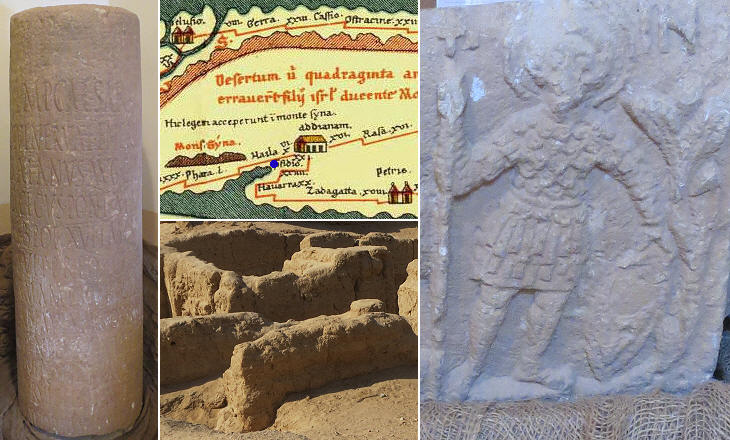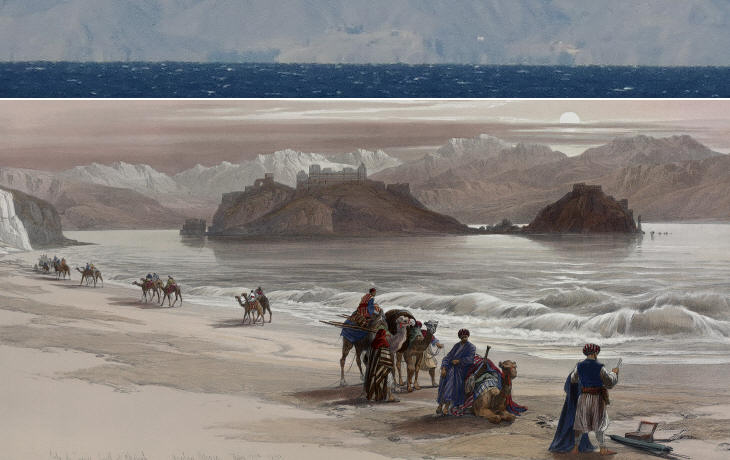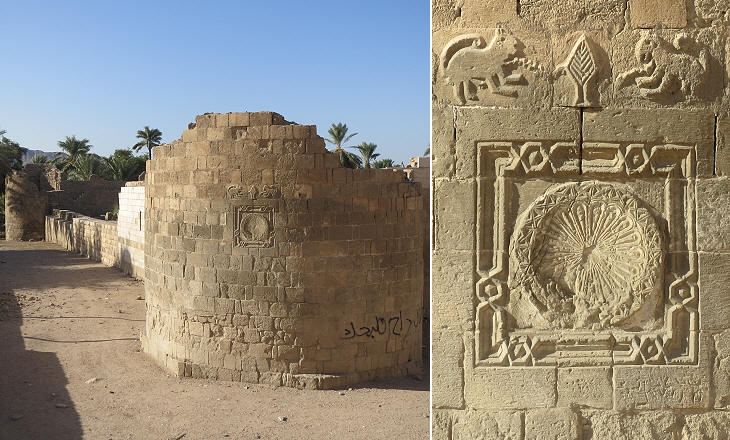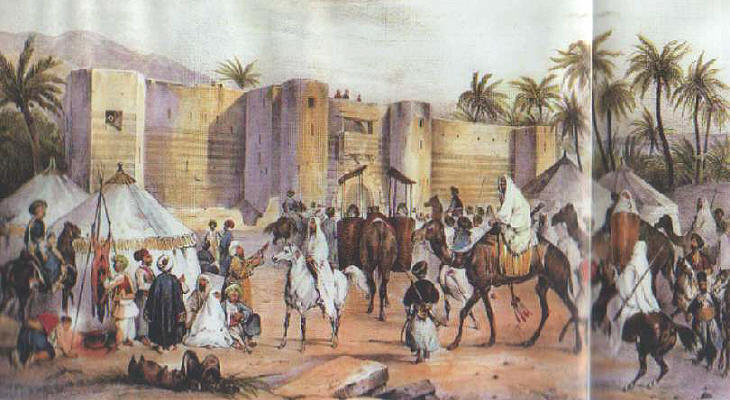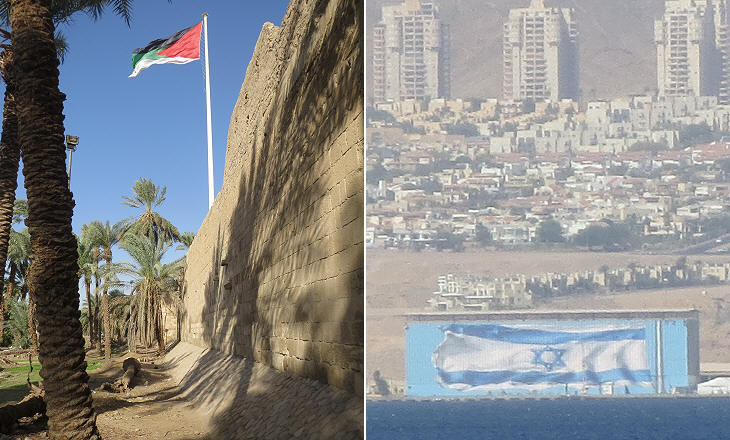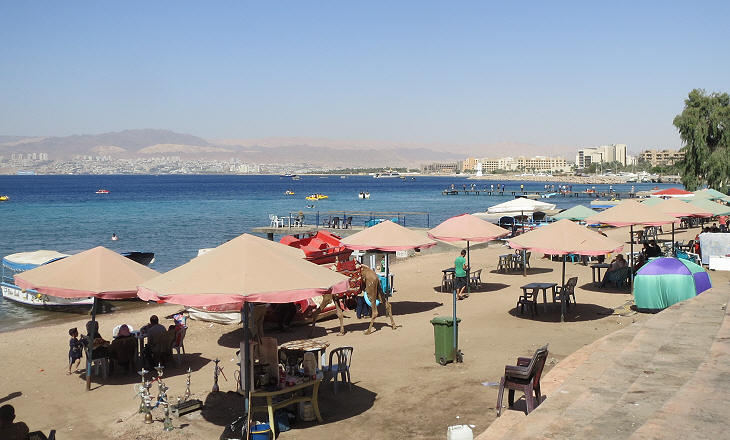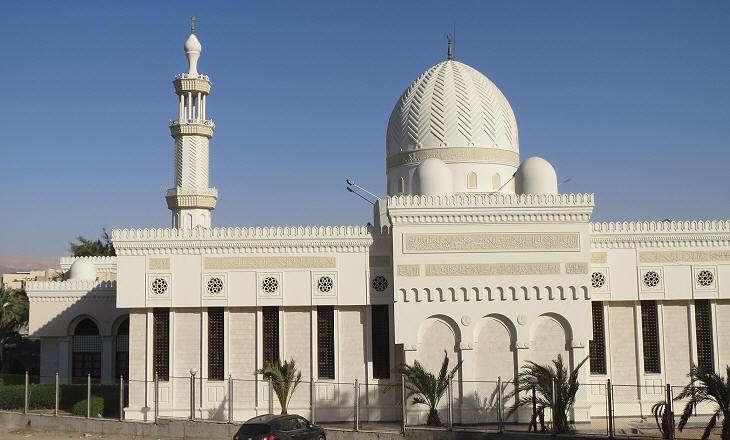  What's New! Detailed Sitemap All images © by Roberto Piperno, owner of the domain. Write to romapip@quipo.it. Text edited by Rosamie Moore. Page added in January 2014. |
 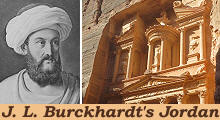 - Aqaba - Aqaba(left: J. L. Burckhardt in Arab attire in a XIXth century engraving; right: the Treasury of Petra) If you came to this page directly, you might wish to read a page with an introduction to this section first. August 22nd. — I was particularly desirous of visiting Wady Mousa (Petra), of the antiquities of which I had heard the country people speak in terms of great admiration; and from thence I had hoped to cross the desert in a straight line to Cairo; but my guide was afraid of the hazards of a journey through the desert, and insisted upon my taking the road by Akaba, the ancient Eziongeber, at the extremity of the eastern branch of the Red sea, where he said that we might join some caravans, and continue our route towards Egypt. I wished, on the contrary, to avoid Akaba, as I knew that the Pasha of Egypt kept there a numerous garrison to watch the movements of the Wahabi (supporters of a religious movement calling for a return to the earliest Islamic practices) and of his rival the Pasha of Damascus; a person therefore like myself, coming from the latter place, without any papers to shew who I was, or why I had taken that circuitous route, would certainly have roused the suspicions of the officer commanding at Akaba, and the consequences might have been dangerous to me among the savage soldiery of that garrison. J. L. Burckhardt - Travels in Syria and the Holy Land - 1822
Eventually Burckhardt reached Egypt without passing through Aqaba, but by crossing the desert between the mountainous region surrounding Petra and the Mediterranean Sea. August 24th. — We saw the great valley (Wadi al-Arabah) forming the continuation of the Ghor. The valley of the Ghor (the River Jordan), which has a rapid slope southward, from the lake of Tiberias to the Dead Sea, appears to continue descending from the southern extremity of the latter as far as the Red Sea, for the mountains on the E. of it appear to increase in height the farther we proceed southward, while the upper plain, apparently continues upon the same level. This plain terminates to the S. near Akaba, on the Syrian Hadj route, by a steep rocky descent, at the bottom of which begins the desert of Nedjed (Negev), covered, for the greater part, with flints. The same descent, or cliff, continues westward towards Akaba on the Egyptian Hadj road.
The existence of a port at the northern end of the Gulf of Aqaba which lies between the Sinai Peninsula and the coast of Arabia is recorded in the Bible. Its location and name changed over time. The Romans and the Byzantines called it Haila. It was situated in the northern part of today's Aqaba, so at the north-eastern end of the gulf. It was the terminal of a maritime route which carried spices and frankincense from Southern Arabia and India to the Mediterranean countries.
The Arabs conquered Haila in the VIIth century and they built a new (very small) town. It had the square shape of Roman camps and it was surrounded by walls. Today it is entirely within the premises of a large hotel. It is possible that it was reserved exclusively for Muslims and that the Christians lived outside it. This because a Christian community at Haila is recorded for many centuries after the Arab conquest.
The Crusaders after a series of raids eventually conquered the town in 1116. The initial construction of a small fortress on an islet near the Sinai coast opposite Ayla is attributed to them. The Ayubbids ousted the Crusaders from the area in 1183, before they conquered Jerusalem in 1187. The fortress on the islet (which today is part of Egypt) was strengthened by the Mamelukes, most likely when the first Portuguese ships made their appearance in the Red Sea.
In 1498 Portuguese explorer Vasco da Gama landed on the south-western coast of India after having circumnavigated Africa. In 1509 the Portuguese defeated an Indian-Mameluke fleet near Diu (a naval base the Portuguese retained until 1961) and they broke the Arab monopoly of spices from India. This had a significant negative impact on Venice which bought spices in Egypt and sold them in Europe with a high profit. The Mamelukes built a fortress to the south of the harbour of Ayla, shortly before the Ottoman conquest of the region. The latter strengthened the sea side of the fortress to make it withstand the impact of Portuguese cannon. This part of the fort was destroyed by British warships during WWI.
The development of new trade routes between India and Europe caused the decline of Aqaba. Charles Doughty, in Travels in Arabia Deserta which was published in 1888, described it as a palm village, still known as Ayla, whereas Akaba was the name of a narrow passage through the nearby mountains. Its economy depended on the yearly passage of the Damascus caravan to Mecca. It was a moving city with thousands of pilgrims and many more camels. An officer, called Amir al-Hajj , was responsible for the safety of the pilgrims. He had a troop of soldiers under his command. It was a challenging task; failure could mean the end of a brilliant career in the Ottoman army.
In 1917 the Arabs of today's Saudi Arabia rebelled against the Ottomans; they were supported by the British who were at war with the Ottomans. Aqaba was conquered by the rebels in July 1917. They were led by members of the Hashemite family who claimed ancestry from the family of Prophet Muhammad. The flag of the Arab Revolt had a religious significance. The horizontal stripes were a reference to to the Umayyad (white), Abbasid (black) and Fatimid (green) Caliphates, whereas the red triangle was the symbol of the Hashemites. It was a way to indicate that the Ottoman Sultan was not a legitimate Caliph. A gigantic flagpole was erected in 2004 near the fortress. In 2013, in a sort of tit for tat response, the City of Eilat, which stands opposite Aqaba, painted the largest Israeli flag in the world on a concrete hangar.
Today the economy of Aqaba is booming. It is the entry port of Chinese products to Jordan and other Arab countries. Its beaches and coral reefs are visited by bathers and snorkellers from all over the world. Its many liquor shops attract customers from neighbouring Saudi Arabia. The border with Israel was opened in 1994. In 2001 a Special Economic Zone was set up by Jordanian authorities to favour the development of new businesses.
Move to: Introductory Page Ajlun Castle and Pella (May 3rd, 1812) Amman and its environs (July 7th, 1812) "Castles" in the Desert (incl. Qasr el-Azraq) Jerash (May 2nd, 1812) Madaba (July 13th, 1812) Mt. Nebo and the Dead Sea (July 14th, 1812) On the Road to Petra (incl. Kerak and Showbak) (July 14th - August 19th, 1812) Petra (August 22nd, 1812) Umm al-Jimal Umm Qays (May 5th, 1812)  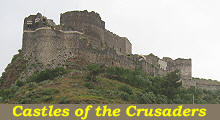  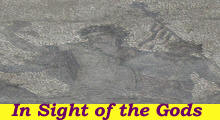
|
